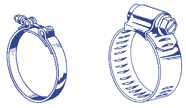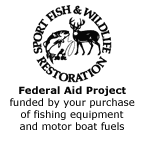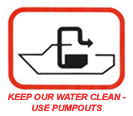Toilets
- Do not flush paper towels or feminine hygiene products. They will clog waste system plumbing. Keep paper usage to a minimum. Some skippers require that nothing be flushed down a toilet that hasn't been eaten first!
- Toilet bowls should be cleaned periodically with water and a biodegradable detergent that can then be flushed through the system. This should be followed with more water mixed with a little mineral or baby oil or one of many specialized marine toilet treatment products available to keep all rubber parts in good condition.
Caution: Do not use toilet bowl cleaners, bleach, drain cleaner, or deodorants unless made specifically for marine toilets. These substances can attack and even destroy some waste system components and harm the environment.
- To discourage calcium buildup, periodically pour a cup of vinegar (a weak acid) into the toilet and allow it to sit before pumping the bowl dry. Left alone, calcium deposits will build up in valves and piping, and eventually clog the toilet. At that point, disassembly (and replacement of some parts) may be the only recourse.
- If marine life routinely gets into the toilet when flushing water, install a strainer (external, internal or both) on the flush water intake line.
- A Teflon-based waterproof grease coating on a manual toilet's piston rod prolongs the life of the piston rod seal.
- All wire terminals on electric toilets should be checked periodically for corrosion and cleaned when necessary. Spray them with a corrosion inhibitor.
- Keep a toilet repair kit onboard with a full set of replacement seals. It's never an issue of "if" toilet seals will fail but "when."
- Improper winterizing can damage a toilet. You can't simply pump it dry and leave it. Water will be trapped in low spots in both the suction and discharge lines as well as in the pump housing. Instead, close the suction seacock, disconnect the hose, and dip it into a can of antifreeze. Use propylene glycol only; alcohol will swell up rubber parts. Pump the toilet until the antifreeze washes down the side of the bowl and flows out the discharge.
Caution: make sure the antifreeze is environmentally friendly and compatible with sewage system components. Select one that will not attack plastic, rubber or metal components. Propylene glycol is generally recommended.
Holding tanks
- Rinse and flush the holding tank after each pumpout. This will dilute any residual sewage and, thereby, reduce odors.
- At the end of the boating season, pumpout and rinse the tank before winterizing the waste system. As a rule, it is best to leave the system drained and dry.
- Keep the holding tank inspection port gasket greased to maintain its seal. Apply lubricant each time the port is opened and resealed.
Tank level monitors
- Wire terminals should be checked periodically for corrosion and cleaned when necessary. Spray them with a corrosion inhibitor.
Seacocks/through-hulls
- Service and lubricate periodically to assure ease of operation.
Deck fittings
- Lubricate threads at deck plate fitting.
Piping Hose
- To find out if hose permeation is the cause of persistent odors, rub a cloth on each hose section, then sniff it. If the cloth smells, the hose is permeated and must be replaced (plastic tanks can be checked for permeation in the same way). If the cloth doesn't smell, check each hose connection for leaks.
Clamps

- Check clamps periodically for corrosion and replace as indicated.
- Check that clamp edges are not cutting into hoses. This commonly happens when clamps are overtight.
Vent fittings
- Keep vent fitting opening(s) free of corrosion, insect nests or other material that may result in a clogged vent line.
Vent line filters
- For effective odor control, replace filters at the start of each boating season. They must also be replaced whenever the holding tank is overfilled (overpressured) and sewage is forced up into the vent line.
Siphon breaks
- Unscrew the vent valve periodically and wash it with fresh water to prevent clogging.
Pumps
- Keep pump manufacture's recommended spares kit on board.
- Consult owner's manual or manufacturer's data sheet for periodic maintenance requirements.
Sewage treatment equipment
- Consult owner's manual for periodic maintenance requirements.


Developed by
The American Boat & Yacht Council
in cooperation with
U.S. Department of the Interior
Fish & Wildlife Service
and
Maryland Department of Natural Resources
Boating Administration
September 1997
Your purchase fishing equipment and motor boat fuels supports
Sport Fish Restoration and pumpout dump station facilities.